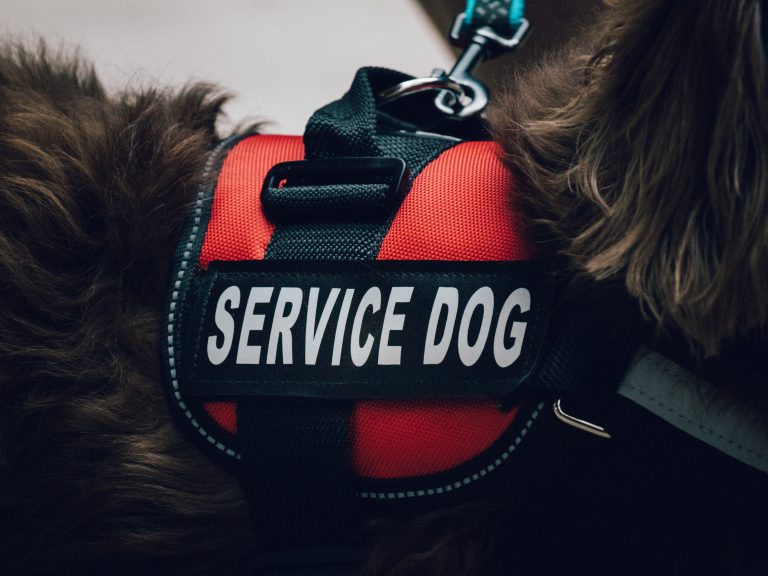Dogs have been working partners to humans from almost the moment they joined us by the fireside all those thousands of years ago. They’re companions, protectors, family members. They can help sniff out cancer, detect dangerous allergens, and even fetch discarded bats and balls at sporting events. Dogs, put simply, can do it all. (Pretty much.)
Thanks to their responsiveness to humans (and vice versa), many dogs have also taken on official work helping people, whether as service dogs who help individuals; therapy dogs who visit vulnerable populations to help alleviate anxiety, stress, and fear; working dogs who perform tasks for an organization; or emotional support dogs who help improve their owners’ ability to deal with mental-health challenges.
While all working dogs perform important roles, there are significant differences between these canines, including important legal distinctions. Here’s a breakdown of the difference between service dogs, therapy dogs, and emotional support dogs.
Service dogs

Service dogs are “individually trained to do work or perform tasks for the benefit of an individual with a disability, including a physical, sensory, psychiatric, intellectual, or other mental disability” and are legally defined and protected by the Americans with Disabilities Act (ADA). While there is no singular body that trains and certifies service dogs, most service dogs are trained by non-profit organizations, due to the high cost of the specialized training required.
Each service dog you see was trained with the needs of their owner in mind, so no two service dogs have the same skill set. Some examples of skills include: navigating for people who are blind or low-vision, pulling a wheelchair, retrieving items, protecting someone who is having a seizure, alerting a handler to allergens, low blood sugar, or other dangerous circumstances, and even calming someone experiencing a mental-health crisis.
Service dogs help their people achieve or maintain independence by assisting them with tasks that would otherwise make them dependent on others. As such, the ADA protects the rights of people to bring their service dogs to most public places, including restaurants, hotels, government agencies, shops, and more places where pets are not allowed. Service dogs are also allowed to travel with their owners on airplanes, thanks to the 1986 Air Carrier Access Act and live in housing with no-pet policies thanks to the Fair Housing Act. The only time a service dog may be denied entry is when its presence could present a legitimate threat to safety.
While the ADA doesn’t require service dogs to wear vests or patches identifying them as working dogs, many people opt to thusly outfit their dogs to minimize interference while they’re working.
Therapy dogs

Courtesy of Alicia Harantschuk
Therapy dogs are working dogs who are trained and certified to provide comfort to people who need it, but they do not have the same protections and privileges as service dogs.
Therapy dogs work in a volunteer capacity, visiting populations who need help with stress relief, managing anxiety, depression, and grief, and even experience higher levels of discomfort than the general population. They’re trained to handle situations such as being pet by multiple people at a time, being offered food they’re not allowed to eat, and being surrounded by specialized equipment, such as medical carts, IV towers, canes, and more.
Therapy dogs must possess a calm temperament and the ability to pass a certification process that tests their ability to ignore stimuli and handle overwhelming situations. When they’re certified, therapy dogs go with their owners to designated settings such as hospitals, nursing homes, schools, assisted living facilities, airports, and emergency disaster sites.
While they are working dogs, they spend most of their lives as pets, so they are not allowed in public places with no-pet policies, nor are they protected under the Fair Housing Act.
Interested in learning more about therapy dogs? Read “How to Train a Therapy Dog” for more information on the skills required to volunteer.
Emotional support dogs

Emotional support dogs (ESDs or ESAs) are pets that can provide therapeutic relief and are prescribed by a mental health professional. There are no certification or training requirements for ESDs.
While every dog owner knows that dogs help us live longer, happier lives, the emotional support provided by ESDs goes above and beyond the typical mental health support most people experience. ESDs help increase the quality of life for people dealing with significant mental health challenges.
According to the ADA’s fact sheet, “The crime deterrent effects of an animal’s presence and the provision of emotional support, well-being, comfort, or companionship are not considered work or tasks under the definition of a service animal.”
That means that while a prescription for an ESD is sometimes accepted at public places and housing where there are no-pet policies, emotional support dogs are not protected by the law and can, in fact, be denied entry to public spaces. In fact, while emotional support animals used to be allowed on airplanes, many airlines no longer recognize emotional support animals as service animals, and as such they must be treated as regular pets when flying, either stowed below the owner’s seat or kept in the cargo hold.









